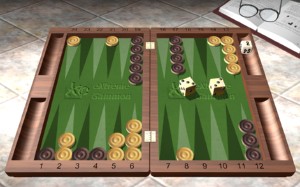Cash game. Black owns the cube. White on move.

White to play 3-3.
White’s off to a good start in this position. He’s already made a three-point board, whereas Black hasn’t yet made a new point, and White has hit a blot, leaving him 17 pips ahead in the race. Black, meanwhile, is still scrambling to make an anchor. Last turn White offered an aggressive double, and Black quite reasonably took.
Now White throws one of his best shots, 3-3, and has three game plans:
(a) The consolidation play with 14/8 13/10(2), leaving him firmly in control with a nice edge, or
(b) Consolidation plus a little attack with 24/21 14/8 6/3*, or
(c) All-out blitz with either 13/4*/1* or 13/4* 6/3*.
What’s the right idea?
Here’s the general approach for handling these sorts of positions. If your opponent has no structure, and the cube has already been turned (activating gammons), then the blitz dominates any safe game plan. If the blitz fails, White can just drop back into some sort of holding game where he holds a slight edge. If White makes one of the solid plays, he’ll reach those holding games anyway since almost all of Black’s rolls will anchor somewhere. White will be slightly better off if he goes for the holding game right away, because of his racing lead, but the difference is small. But if the blitz succeeds White wins a gammon, and with the cube already turned that’s a quick four points and a huge swing.
As Black acquires more structure, the blitz drops in value. If we alter Black’s position and give him his 5-point (as though he had rolled a 3-1 at some time), then the blitz plays are only slightly superior to the consolidating plays. If we give Black two extra points, say the 5-point and the 3-point, then the blitz plays become pretty big errors and the consolidating plays becomes correct. (There’s very little difference between Play (a) and Play (b) no matter what structure Black has.)
So we’re blitzing. Next question: what’s the right way to blitz?
What makes this problem especially interesting is that White has two distinct ways to blitz: the obvious 13/4*/1* and the obviously riskier 13/4* 6/3*. Problems with two plausible blitzing moves are rare, but we can choose between them by noticing that the double-hit with 13/4*/1* exposes only one blot in the board, and a hit may only allow Black to get an ace-point game later. If White hits on the 3-point and 4-point with two checkers and Black then throws a three or four, he may get a good anchor quickly. The two blitzing plays are close (and far superior to the non-blitzing plays) but the play that exposes only one inside blot is slightly better.





